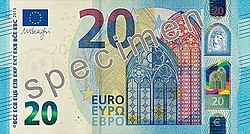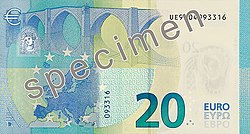
Back ورقة 20 يورو Arabic ২০ ইউরো নোট Bengali/Bangla Bitllet de vint euros Catalan Χαρτονόμισμα 20 ευρώ Greek Billete de veinte euros Spanish 20-eurone rahatäht Estonian Billet de 20 euros French Billete de 20 euros Galician Uang 20 Euro ID Banconota da 20 euro Italian
| (Eurozone (mainly) and other countries) | |
|---|---|
| Value | 20 euro |
| Width | 133 mm |
| Height | 72 mm |
| Security features | First series: hologram stripe with perforations, reflective glossy stripe, EURion constellation, watermarks, microprinting, ultraviolet ink, raised printing, security thread, matted surface, see-through number, barcodes and serial number[1] Europa series: portrait watermark, portrait hologram, portrait window, emerald number[2] |
| Material used | 100% pure cotton fibre[3] |
| Years of printing | 1999–2014 (1st series)[citation needed] Since 2014 (Europa series)[citation needed] |
| Obverse | |
 | |
| Design | Window in Gothic architecture[4] |
| Designer | Robert Kalina (1st series)[5] Reinhold Gerstetter (Europa series)[6] |
| Design date | 3 December 1996 (1st series)[5] 24 February 2015 (Europa series)[7] |
| Reverse | |
 | |
| Design | Bridge in Gothic architecture and map of Europe[4] |
| Designer | Robert Kalina (1st series)[5] Reinhold Gerstetter (Europa series)[6] |
| Design date | 3 December 1996 (1st series)[5] 24 February 2015 (Europa series)[7] |
The twenty euro note (€20) is the third-lowest value euro banknote and has been used since the introduction of the euro (in its cash form) in 2002.[8] The note is used in the 25 countries (and Kosovo) that have it as their sole currency (with 24 legally adopting it), which countries have a total population of about 350 million currently.[9] In July 2024, there were approximately 4,818,000,000 twenty euro banknotes in circulation around the eurozone. It is the second most widely circulated denomination, accounting for 16.3% of the total banknotes.[10] Estimates suggest that the average life of a twenty euro banknote is about two years before it is replaced due to wear.[11]
It is the third-smallest note, measuring 133 x 72 mm with a blue colour scheme.[4] The twenty euro banknotes depict bridges and arches/doorways in Gothic architecture (between the 13th and 14th centuries). The twenty euro note contains several complex security features such as watermarks, invisible ink, holograms and microprinting that document its authenticity.
The design of the Europa series 20 euro banknote was revealed on 24 February 2015 and launched on 25 November 2015.[12]
- ^ "ECB: Security Features". European Central Bank. 2008. Archived from the original on 28 May 2013. Retrieved 13 October 2011.
- ^ "ECB: Security features". European Central Bank. ecb.int. Retrieved 9 July 2015.
- ^ "ECB: Feel". European Central Bank. 2002. Archived from the original on 21 October 2011. Retrieved 9 October 2011.
- ^ a b c "ECB: Banknotes". European Central Bank. 2002. Retrieved 13 October 2011.
- ^ a b c d "Banknotes design". ECB.int. European Central Bank. February 1996. Archived from the original on 10 May 2013. Retrieved 13 October 2011.
- ^ a b "Europa series design - ECB - Our Money". www.new-euro-banknotes.eu. 2013. Retrieved 6 August 2013.
- ^ a b "ECB: Europa series". ECB. 2013. Retrieved 24 June 2013.
- ^ "Witnessing a milestone in European history". The Herald. Back Issue. 1 January 2002. Archived from the original on 8 November 2012. Retrieved 23 October 2011.
- ^ * "ECB: Map of euro area". ECB. ecb.int. 1 January 2023. Retrieved 25 November 2024.
- "By monetary agreement between France (acting for the EC) and Monaco". 31 May 2002. Retrieved 30 May 2010.
- "By monetary agreement between Italy (acting for the EC) and San Marino". 27 July 2001. Retrieved 30 May 2010.
- "By monetary agreement between Italy (acting for the EC) and Vatican City". 25 October 2001. Retrieved 30 May 2010.
- "By monetary agreement between European Union and the Principality of Andorra". 17 December 2011. Retrieved 25 November 2024.
- ^ "ECB Statistical Data Warehouse,Reports>ECB/Eurosystem policy>Banknotes and coins statistics>1.Euro banknotes>1.1 Quantities". ECB. European Central Bank.
- ^ "Eurozone's new 5-euro note: Coming to a wallet near you". Deutsche Welle.
- ^ "New €20 banknote unveiled in Frankfurt today". European Central Bank. 24 February 2015.
© MMXXIII Rich X Search. We shall prevail. All rights reserved. Rich X Search